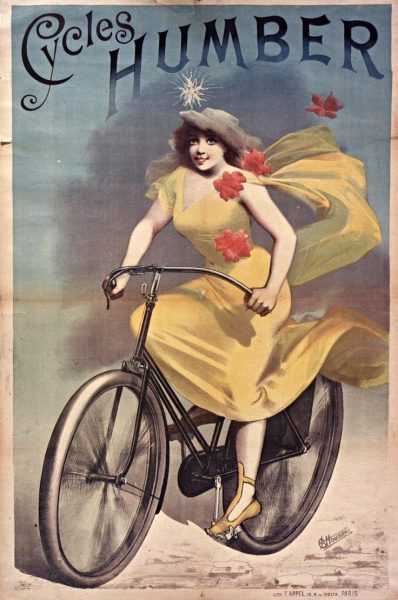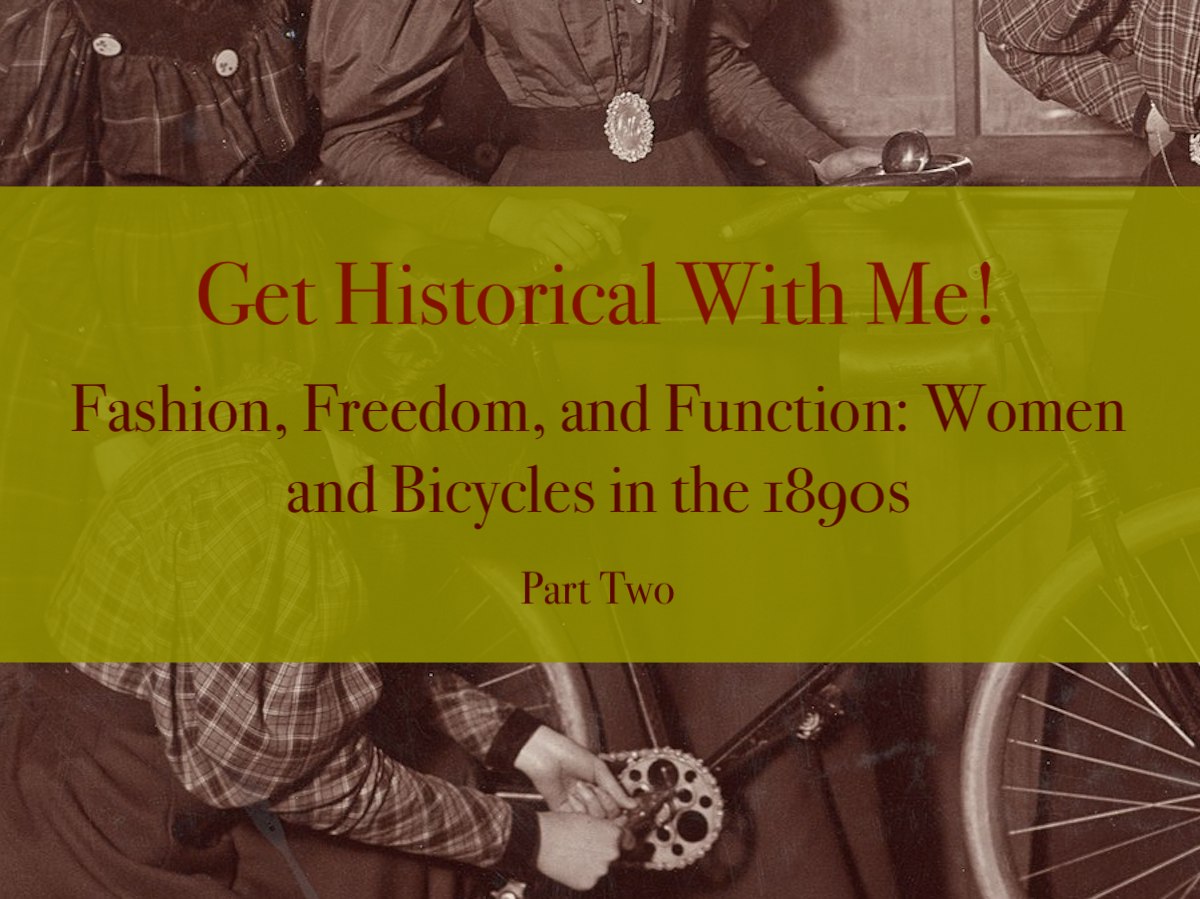Bicycles were a big deal for women in the 1890s, but why? Was it just a fashion statement, or did it really give women a sense of freedom and emancipation from standard gender roles? In part two of my series, I will show how bicycles became more useful to women at the time, why they rode them, and what stood in their way. You can catch up with part one of the series here.
As years went by, more experimentation in bicycle design took place. Gearing systems and chains were introduced, better braking systems were implemented, and springs were installed to cut down on vibration issues. The wheels of the bicycle, rather than having one huge wheel and one small, became more equal in size. Finally, the tire on the bicycle went from a solid rubber tire to one filled with air, which solved multiple issues, including vibration and traction. The safety bicycle had finally come to be, evolving over the course of about eighteen years (the very late 1870s-the early to mid-1890s) to become the bicycle we are more or less familiar with today.
With the safety bicycle being lower to the ground and much easier to ride, it became accessible to many more people, including women. Advertisers latched on to women as a target audience for the bicycle right away, taking advantage of the stylish aspects of it, the fact that it was popular among the upper classes, and using artwork to suggest not only that the bicycles were aesthetically pleasing, but women who rode on bicycles would be decorous as well. While there were detractors and many people who disapproved of women riding bicycles, once women started to ride, nothing seemed to discourage them.

One source of disapproval of women riding was the medical field. Many doctors claimed women were not physically able to ride a bicycle safely. Much of this stemmed from the fact that women had to straddle the bicycle in order to ride. Doctors claimed it was too stimulating for women, that it would affect her childbearing by disfiguring her reproductive organs, and that any sign of slouching in the seat of the bicycle was a sign that a woman was giving in to her devious sexual nature. This is one reason images of the time depicted women sitting straight and tall on their bicycles while their male counterparts are bent closer to the handlebars for better aerodynamics.
Gender and social norms, however, seemed to be the largest opponent to female cyclers. Magazines were full of images that made fun of women for thinking they could enter the masculine sphere. One popular trope of these “humorous” pieces was the man doing housework while his wife stood over him, wearing trousers, smoking, and watching him. American minstrel Frank Dumont said, in his 1912 book The New Woman’s Husband, “Here’s a nice position for a man. I’ve got to scrub the floor and do all the housework, just because my wife wants to go out riding on her bike. Oh! This is what I get for marrying a new woman.”

These things seem to have a lighthearted tone to them, jesting about the situation. There were plenty of situations, however, where women found themselves facing criticism in a far more negative, and sometimes even dangerous, way. Women described being laughed, jeered, and shouted at from the sides of the road, with some of the comments bordering on obscene. Men in particular seemed to take joy in criticizing every aspect of a woman’s riding, from her technique, to her bicycle, to her clothing, to her prospects of marriage. People who supposedly supported women riding bicycles would even make comments about their senses of direction or ability to make quick decisions.
Clearly, however, the benefits women got from riding bicycles outweighed these negative things. Popularity of bicycles among women only grew throughout the 1890s, as evidenced by the amount of advertising geared toward them for everything from the bicycles themselves to clothing, saddles, and more. Many of the advertisements made a conscious effort to negate many things the nay-sayers were putting forth, including medical claims.

One way women combatted the negativity toward them was to work hard at being competent at their sport. In the 1890s, multiple guides were written by women for their sister cyclists. One popular guide was Ida T. Bell’s Bicycling for Women, published in 1890, which was endorsed by the Pope bicycle company. This guide was written with the assumption riders would be upper class women who were domestically inclined, and focused very much on cycling to enhance femininity. The book laid out expectations for women as far as the conditions under which they should ride; for example, always with a male companion. It took a very conventional view on women, which isn’t surprising since it was coming from an actual company as a form of advertising, and they didn’t want to risk alienating an audience.
Contrasting this were two books written by women outside of the bicycling industry, who were enthusiasts themselves, and who took an interest in making cycling accessible to as many women as possible. Maria E. Ward’s book The Common Sense of Bicycling: Bicycling for Ladies is a very down-to-earth and practical guide. Ward has a no-nonsense, almost stern tone throughout the book, which promoted women to be self-sufficient. Her philosophy was that in order to cut back on criticism, which would happen to some extent no matter what, a woman needed to know her bicycle inside and out and be able to do all the maintenance and repairs on it herself. She needed to practice riding a lot so she was good at it, and in doing so, would not give anyone fodder with which to make fun of her. She hardly mentions domestic life at all in the book, neither does she talk about the bicycle being used for courtship. A woman’s bicycle was her own.

Frances E. Willard’s book, A Wheel Within a Wheel, is almost a middle ground between the Bell and Ward book. Willard was the president of the Women’s Christian Temperance Union, and was more conservative than Ward. Her book reads more like a memoir of her own experience learning how to ride. Unlike Ward’s book, Willard’s is not an instruction manual, and there isn’t any technical information about the bicycle in it. Her guide is more introspective, with the purpose of encouraging women to be more confident in themselves, not only in bicycling, but in life itself. She was a proponent for the bicycle leading to social change, like Ward, and thought that by women riding alongside men, men could be influenced in a positive way to lose their sense of superiority and see women as more equal to them. Willard also suggested women could use cycling as a way to come together and support each other. Manuals like Ward’s and Willard’s were widely distributed in the 1890s, and aided in creating a women’s cycling culture, which not only included the bicycling itself, but also the clothing and attitudes involved in cycling.
What impacts did this women’s cycling culture have on the rest of society in the 1890s? Stayed tuned for the concluding part of this series, coming up next week!
Further reading:




